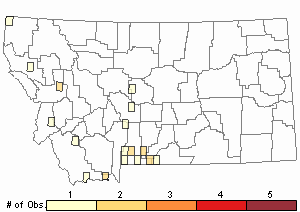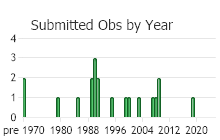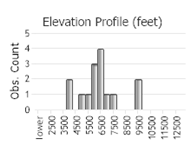View in other NatureServe Network Field Guides
NatureServe
Montana
Utah
Wyoming
Idaho
Wisconsin
British Columbia
South Carolina
Yukon
California
New York
Many-ribbed Sedge - Carex multicostata
State Rank Reason (see State Rank above)
A rare species in Montana, scattered in the mountains of the southwest and south-central portions of the state. Very little data are available for the species in Montana. However, the potential for negative impacts to the popoulations appears to be low.
General Description
Cespitose or with very short rhizomes; stems 15-70 cm tall. Laves on lower quarter of stems, the lower ones bladeless or nearly so, the upper ones with blades 2-4 mm wide. Lowest bract lacking or shorter than the inflorescence. Inflorescence 1.5-4 cm long, 14-20 mm wide, spikes congested. Spikes 5-10, gynaecandrous, 6-10 mm long, sessile; pistillate scales subequal to the length and width of perigynia or somewhat shorter, light reddish brown or brown and with a pale 3-nerved midstripe and hyaline margins 0.1-0.3 mm wide; perigynia 4.5-6.2 mm long, narrowly to broaldy ovate, plano-convex, obscurely to conspicuously multi-nerved on both sides or nervless or few-nerved ventrally, winged and serrulate, tapering to a prominent slender or more or less flattened beak, this margined and serrulate to near the apex or terete and entire for up to 0.6(-1.0) mm; stigmas 2; achenes lenticular (adapted from: Welsh et al. 1993, A Utah Flora, 2nd ed.).
Phenology
Flowering and fruiting in July.
Diagnostic Characteristics
Many species resemble C. mutlicostata. The relatively long perigynium with its 10 or more distinct outer nerves are distinguishing characters among related species. It differs from the more common C. phaeocephala by its relatively wider leaves greater than 2 mm. A hand lens or microscope and technical key are essential for separating the many Carex species.
Range Comments
BC to MT, south to CA, NV and UT (Kartesz in prep. 2012).
Observations in Montana Natural Heritage Program Database
Number of Observations: 22
(Click on the following maps and charts to see full sized version)
Map Help and Descriptions
Relative Density

Recency



 (Observations spanning multiple months or years are excluded from time charts)
(Observations spanning multiple months or years are excluded from time charts)
Habitat
Grasslands and meadows in the montane and subalpine zones.
Stewardship Responsibility
References
- Additional ReferencesLegend:
 View Online Publication
View Online Publication
Do you know of a citation we're missing? Culver, D.R. 1994. Floristic analysis of the Centennial Region, Montana. M.Sc. Thesis. Montana State University, Bozeman. 199 pp.
Culver, D.R. 1994. Floristic analysis of the Centennial Region, Montana. M.Sc. Thesis. Montana State University, Bozeman. 199 pp. Eggers, M.J.S. 2005. Riparian vegetation of the Montana Yellowstone and cattle grazing impacts thereon. M.Sc. Thesis. Montana State University, Bozeman, MT. 125 p.
Eggers, M.J.S. 2005. Riparian vegetation of the Montana Yellowstone and cattle grazing impacts thereon. M.Sc. Thesis. Montana State University, Bozeman, MT. 125 p. Hermann, F. J. 1970. Manual of the Carices of the Rocky Mountains and Colorado Basin. Agricultural Handbook No. 374. USDA Forest Service. 397 pp.
Hermann, F. J. 1970. Manual of the Carices of the Rocky Mountains and Colorado Basin. Agricultural Handbook No. 374. USDA Forest Service. 397 pp. Lesica, P., M.T. Lavin, and P.F. Stickney. 2012. Manual of Montana Vascular Plants. Fort Worth, TX: BRIT Press. viii + 771 p.
Lesica, P., M.T. Lavin, and P.F. Stickney. 2012. Manual of Montana Vascular Plants. Fort Worth, TX: BRIT Press. viii + 771 p. Lesica, P., M.T. Lavin, and P.F. Stickney. 2022. Manual of Montana Vascular Plants, Second Edition. Fort Worth, TX: BRIT Press. viii + 779 p.
Lesica, P., M.T. Lavin, and P.F. Stickney. 2022. Manual of Montana Vascular Plants, Second Edition. Fort Worth, TX: BRIT Press. viii + 779 p. Mathews, S.Y. 1989. Sensitive plant surveys, 1989: United States Forest Service, Region 1, Gallatin National Forest, Montana. Unpublished report to the USDA Forest Service, Gallatin National Forest, Bozeman, Montana. Montana Natural Heritage Program, Helena, MT. 85 pp.
Mathews, S.Y. 1989. Sensitive plant surveys, 1989: United States Forest Service, Region 1, Gallatin National Forest, Montana. Unpublished report to the USDA Forest Service, Gallatin National Forest, Bozeman, Montana. Montana Natural Heritage Program, Helena, MT. 85 pp. Poole, J.M. and B.L. Heidel. 1993. Sensitive plant surveys in the Big Belt and Elkhorn Mountains, Helena National Forest, Montana. Unpublished report to the Helena National Forest. Montana Natural Heritage Program. Helena, MT. 129 pp. plus printouts, maps.
Poole, J.M. and B.L. Heidel. 1993. Sensitive plant surveys in the Big Belt and Elkhorn Mountains, Helena National Forest, Montana. Unpublished report to the Helena National Forest. Montana Natural Heritage Program. Helena, MT. 129 pp. plus printouts, maps.
- Web Search Engines for Articles on "Many-ribbed Sedge"





